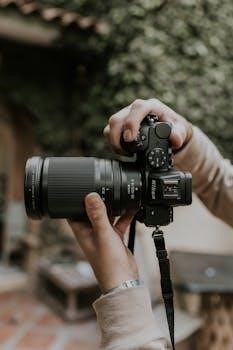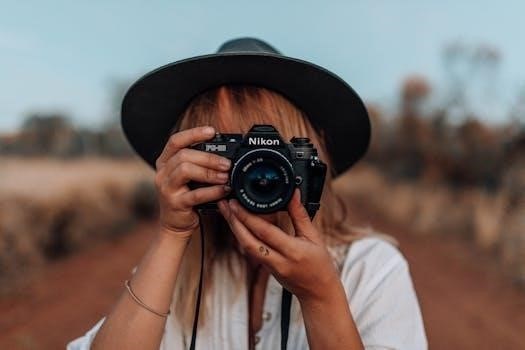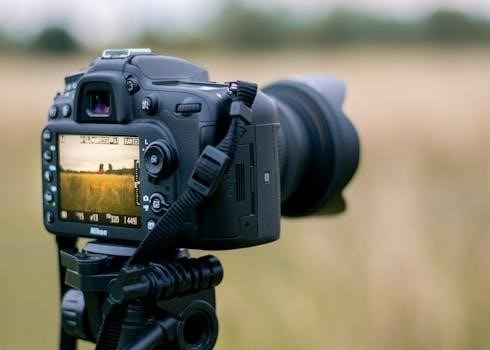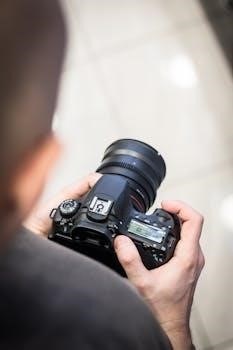Nikon D80 Camera Manual⁚ A Comprehensive Guide
Welcome to your comprehensive resource for the Nikon D80‚ a popular digital SLR camera. This guide offers a deep dive into the camera’s features and functions. Whether you’re a beginner or experienced photographer‚ this is your starting point for mastering the D80.
The Nikon D80 is a digital single-lens reflex (DSLR) camera that was released by Nikon‚ designed for both enthusiast and professional photographers. It boasts a 10.2-megapixel CCD sensor‚ which contributes to its ability to capture high-quality images with rich detail and vibrant colours. The camera features a 2.5-inch LCD screen‚ which provides a clear display for reviewing photos and navigating the menu system‚ making it an easy to handle camera for all skill levels. Its robust build quality and ergonomic design ensure comfortable handling and durability. The D80 offers a range of shooting modes‚ including aperture-priority‚ shutter-priority‚ manual‚ and program modes. It also has a built-in flash and is compatible with various Nikon lenses. This model was widely praised at its launch for its image quality‚ performance‚ and user-friendly interface‚ setting a high standard for DSLR cameras in its class. The Nikon D80 is an excellent camera for a range of photography genres‚ from portraits and landscapes to action and low-light photography‚ making it a versatile choice for any photographer.

Downloading the Nikon D80 Manual
Accessing the Nikon D80 manual is straightforward‚ with several online resources offering it for free download. The manual is typically available in PDF format‚ allowing easy viewing on various devices such as computers‚ tablets‚ and smartphones. To obtain the manual‚ you can begin by visiting the official Nikon website or dedicated support pages for older models. There‚ you’ll usually find a section for manuals and downloads where you can search for the D80 specifically. Other reputable websites providing free manuals also host the Nikon D80 manual. When downloading‚ ensure the source is trustworthy to avoid potentially harmful files. Once downloaded‚ you can save the file for future reference. The PDF format is searchable‚ making it easy to find specific information. Remember to check if multiple language versions are available to select your preferred one. Keeping a digital copy on hand allows you to easily access information. This accessibility to the manual makes it a valuable resource for any D80 user to maximize their camera’s potential and solve any issues.

Navigating the User Manual
Understanding the structure of the Nikon D80 user manual is essential for efficient use. The manual is typically organized into sections‚ each covering a specific aspect of the camera. The initial parts often detail basic camera operations‚ explaining the functions of buttons and dials. Following this‚ you’ll usually find sections on menu navigation‚ image settings‚ and shooting modes. Chapters dedicated to specific features‚ such as autofocus‚ white balance‚ and flash‚ provide in-depth explanations. The manual may also include troubleshooting tips for common issues. To navigate effectively‚ use the table of contents to find specific topics. Most PDF versions allow you to search for keywords‚ making it easy to locate particular information. Look for visual aids like diagrams and screenshots to clarify complex operations. Pay attention to any notes or warnings highlighted in the text. Familiarizing yourself with the manual’s structure will greatly enhance your ability to quickly find answers. This methodical approach will help in efficiently mastering the camera’s various functions and capabilities. The manual is an invaluable resource‚ so understanding its layout will make it a much more useful tool.
Key Features and Specifications
The Nikon D80 boasts a 10.2-megapixel CCD sensor‚ delivering high-resolution images with fine detail and vibrant colors. It has a 2.5-inch LCD screen with 230‚000 pixels‚ providing clear previews and menu navigation. The built-in flash is versatile‚ offering options like red-eye reduction and slow sync. The camera is compatible with SD and SDHC memory cards for ample storage. Its dimensions are approximately 132mm wide‚ 103mm high‚ and 77mm deep‚ weighing around 585g making it relatively lightweight. The D80 features a range of shooting modes including aperture priority‚ shutter priority‚ manual and program modes. It supports various white balance settings such as auto‚ incandescent‚ fluorescent‚ and shade. The camera offers multiple autofocus modes like single and continuous focus. It also includes a self-timer function for delayed shots. The D80’s image formats are JPEG and RAW. The camera has a multi-language interface and includes a DC-in jack for external power supply. Key features also include a variety of scene modes like portrait‚ landscape‚ and sports. These specifications make the D80 a capable and versatile camera for various photographic needs.
Understanding the Camera’s Controls
The Nikon D80’s controls are designed for intuitive operation. On top‚ you’ll find the mode dial‚ which allows you to select shooting modes like auto‚ aperture priority‚ shutter priority‚ and manual. The shutter release button is conveniently located near the command dial‚ used for adjusting settings. The ISO button on top lets you quickly change the camera’s sensitivity to light. The back of the camera features the multi-selector‚ a navigational tool for menus and focus points. The playback button lets you review your photos. The menu button accesses the camera’s settings‚ and the delete button removes unwanted images. The AE-L/AF-L button locks exposure and focus. The flash button activates the built-in flash. The image quality and size button sets the resolution of photos. Buttons with green dots reset the settings to default. Familiarizing yourself with these controls will greatly improve your workflow and efficiency‚ allowing you to make quick adjustments while shooting. The camera’s ergonomic design ensures easy access to these controls. The command dial is a key component for adjusting the aperture and shutter speed. This user-friendly layout is essential for capturing your desired shots effectively.
Setting the ISO Sensitivity
Adjusting the ISO sensitivity on your Nikon D80 is crucial for capturing well-exposed images in various lighting conditions. To change the ISO‚ locate the ISO button on the top of the camera‚ typically near the mode dial. Press this button while simultaneously rotating the command dial‚ which is usually located near the shutter release button. This action will bring up the ISO options. The ISO value determines the camera’s sensitivity to light⁚ lower values (like ISO 100 or 200) are suitable for bright conditions‚ producing cleaner images with less noise. Higher ISO settings‚ such as 800‚ 1600‚ or even 3200‚ are needed in low-light situations. However‚ higher ISO levels tend to introduce more digital noise‚ which can degrade image quality. Experiment with different ISO settings to understand how they affect your photos. Knowing when to use the right ISO is an important skill for any photographer. Adjusting the ISO based on lighting will help in capturing images that are properly exposed without being too dark or too bright. The camera offers a range of ISO options to ensure versatility.

Adjusting the Autofocus Points
The Nikon D80 offers a flexible autofocus system that allows you to select specific focus points‚ ensuring sharp and precise images. To adjust the autofocus points‚ use the multi-selector‚ which is located on the back of the camera. The multi-selector is a circular button with directional arrows. By pressing these arrows‚ you can move the active focus point around the frame‚ selecting where the camera should focus. This feature is especially helpful for composing images with subjects not in the center. When you press the center button of the multi-selector‚ the focus point will return to the center of the frame. Using this method‚ you can quickly choose the focus point that suits your composition. This precise control over the focus point is particularly useful for portrait photography or when capturing images of moving objects; The available focus points are displayed in the viewfinder or on the LCD screen‚ allowing you to see where the camera is focusing. Understanding how to manipulate autofocus points is important for getting sharp and well-focused shots. Mastering this will enhance your photographic precision and creative flexibility.
Using the Self-Timer

The self-timer feature on the Nikon D80 is a versatile tool that allows you to include yourself in photos or eliminate camera shake. To use the self-timer‚ first locate the timer button‚ which is situated on the top of the camera‚ typically near the mode dial. Press this button‚ and then rotate the command dial‚ which is near the shutter release button‚ to choose the desired duration for the self-timer. You can typically select from a variety of durations‚ such as 2 seconds‚ 5 seconds‚ or 10 seconds‚ giving you enough time to get into the shot. Once you’ve set the timer‚ press the shutter release button. The camera will then start the countdown‚ and the shutter will automatically activate after the set duration‚ taking the photo. This feature is ideal for group shots or when you need to take a photo without holding the camera. This capability allows you to reduce camera shake‚ especially useful in low-light conditions or when using slow shutter speeds. The self-timer is a simple yet beneficial tool for enhancing your photography. By understanding how to use this function‚ you will greatly improve your photographic versatility.
Utilizing the Built-In Flash
The Nikon D80 features a built-in flash‚ a valuable tool for enhancing your photography in various lighting conditions. The flash is primarily used to add light to your subject‚ particularly in low-light environments‚ or to fill in shadows when shooting outdoors on a sunny day. To activate the built-in flash‚ you will usually need to press the flash button on the camera body. The flash will then pop up‚ indicating that it is ready to fire. The flash settings can be adjusted through the camera’s menu system‚ offering options such as fill flash‚ red-eye reduction‚ and slow sync flash. Fill flash is useful for brightening shadows‚ while red-eye reduction helps mitigate red-eye occurrences in portraits. Slow sync flash allows the flash to fire at the end of the exposure‚ leading to better-balanced images in low-light situations. The built-in flash is a convenience that allows you to take pictures in diverse conditions without carrying an external flash. It’s a great tool to have when capturing memorable images in any setting‚ be it indoors or outdoors. It adds versatility and improves image quality by providing additional light when needed.
Memory Card Compatibility
The Nikon D80 is designed to be compatible with specific types of memory cards‚ ensuring reliable storage for your photos and videos; The primary memory card formats supported by the D80 are Secure Digital (SD) and Secure Digital High Capacity (SDHC) cards. These cards are readily available in various storage capacities‚ giving you flexibility in choosing the amount of space you need. SD cards come in standard sizes‚ while SDHC cards offer higher storage capabilities‚ allowing you to store more high-resolution images and longer video clips. It is important to note that the D80 does not support older memory card formats like CompactFlash. When purchasing memory cards for your D80‚ it’s essential to consider both the storage capacity and the speed class. A higher-speed class will ensure faster data transfer‚ which is especially important when shooting in continuous mode or recording video. Always make sure the memory card is properly inserted into the designated slot on the camera. Using compatible memory cards guarantees smooth operation and helps prevent data loss. SD and SDHC cards provide a reliable‚ convenient and widely available storage solution for your Nikon D80 camera.
Aperture Control
Understanding aperture control is crucial for mastering your Nikon D80. The aperture‚ essentially the opening within the lens through which light passes‚ directly influences both the brightness of your images and the depth of field. On your D80‚ you can adjust the aperture by rotating the command dial‚ which is located near the shutter release button. This allows you to select different f-numbers (f-stops). A lower f-number‚ such as f/2.8‚ indicates a wider aperture‚ letting more light into the camera‚ resulting in a brighter image and a shallow depth of field. A shallow depth of field is perfect for portraits where you want a blurred background. Conversely‚ a higher f-number‚ like f/16‚ represents a smaller aperture‚ limiting the amount of light and creating a greater depth of field where both the foreground and background are in focus. This is ideal for landscape photography. The ability to adjust the aperture is one of the core creative controls of the D80‚ allowing you to influence the look and feel of your photographs. Experimenting with different aperture settings is essential for developing a unique style and mastering the camera’s full capabilities.
White Balance Settings
The white balance setting on your Nikon D80 is essential for achieving accurate colors in your photographs. Different light sources emit different color temperatures; for example‚ incandescent light is warm and yellowish‚ while fluorescent light can be cool and greenish. The D80’s white balance feature allows you to adjust the camera to compensate for these variations. To access these settings‚ press the WB button on the back of the camera and then rotate the command dial. You’ll find several preset options‚ such as ‘Auto’‚ which lets the camera automatically adjust the white balance‚ ‘Incandescent’‚ ‘Fluorescent’‚ ‘Sunny’‚ ‘Shade’‚ and ‘Flash’. Choosing the correct white balance setting based on the lighting conditions ensures that white objects in your scene appear white‚ and all other colors are rendered accurately. If your photos appear too warm or too cool‚ it is a strong indication that you need to adjust the white balance. You may also use the ‘Preset Manual’ mode to calibrate the white balance based on a reference point. Understanding and using your D80’s white balance settings will greatly enhance the quality and color accuracy of your photos‚ giving you more control over the final result.
Troubleshooting Common Issues
Encountering issues with your Nikon D80 is not uncommon‚ but most can be easily resolved with a bit of troubleshooting. One frequent problem is the “Err” message appearing on the LCD screen‚ often indicating a communication error between the lens and the camera body. In such cases‚ try cleaning the lens contacts with a soft cloth and ensure the lens is properly attached. If your shutter isn’t popping up‚ or only does so intermittently‚ check if the battery is fully charged; low battery power can cause this issue. Another common concern is blurry images‚ which may result from slow shutter speeds or incorrect focus settings; ensure your shutter speed is fast enough for the scene or use a tripod for stability. If your photos are too dark or too bright‚ check your exposure settings‚ including aperture‚ shutter speed‚ and ISO. If your camera is not taking photos‚ try resetting it by locating the two green-dotted buttons on the top right of the D80 and pressing them simultaneously. Additionally‚ check your memory card for compatibility and ensure it is not full or write-protected. If you are still experiencing problems‚ consulting the full user manual can provide more detailed solutions.